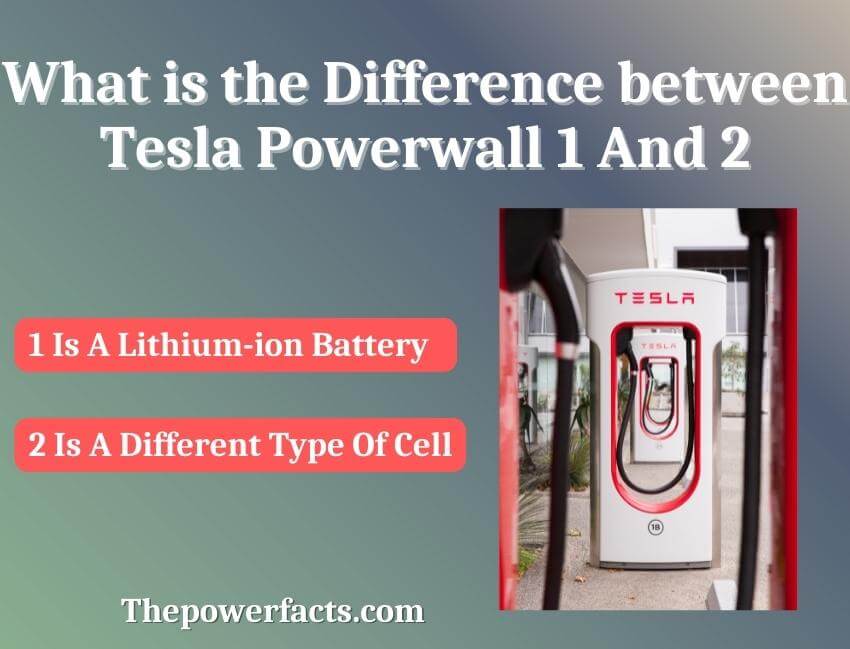In the great world of renewable energy, Tesla stands out with its high-tech solutions, revolutionizing the way we utilize power in our homes. Among their innovative products, the Powerwall home battery systems hold a special place. So, what is the difference between Tesla Powerwall 1 and 2? In this article, we’ll explore the nuances, improvements, and contrasts between these two groundbreaking systems, helping you make an informed choice for your energy needs.

The Tesla Powerwall: A Brief Overview
Before diving into differences, let’s first understand what a Tesla Powerwall is. Essentially, it’s a rechargeable home battery system that stores solar energy or electricity from the grid, providing backup power, peak demand reduction, and energy independence. Designed by Tesla Inc., Powerwall has undergone two main iterations: Powerwall 1 and Powerwall 2.
What is the Difference between Tesla Powerwall 1 And 2?
The difference between Tesla Powerwall 1 and 2 lies predominantly in their capacity, efficiency, design, and features. The Powerwall 2 showcases improved technology, reflecting Tesla’s commitment to continual advancement in the energy storage sector.
Powerwall 1 vs Powerwall 2: Capacity and Efficiency
The Powerwall 1 boasts a respectable 7 kWh of daily cycle capacity and 3.3 kW power output. In contrast, the Powerwall 2 significantly increases these figures, delivering a hefty 13.5 kWh of energy storage and 5 kW continuous power.
Design and Installation Differences
While Powerwall 1 featured a curved, distinctively futuristic design, Powerwall 2 has a more practical rectangular form. It also includes a built-in inverter, simplifying the installation process and reducing hardware costs.
Feature Improvements in Powerwall 2
The Powerwall 2 offers enhanced features like time-based control, which allows you to dispatch stored power when electricity costs are high, thus saving on your energy bill.
The In-Depth Analysis: Powerwall 1
Powerwall 1: The Pioneer
When it first hit the market in 2015, Powerwall 1 was nothing short of revolutionary. It introduced the concept of affordable, reliable home energy storage. Yet, as with all pioneers, it had room for improvement.
Features and Specs
The Powerwall 1 offered two models: a 7 kWh model for daily cycling and a 10 kWh model for weekly cycling. Both models have a 92% round trip efficiency, a testament to the system’s high performance.
An In-Depth Look: Powerwall 2
Powerwall 2: The Evolution
Tesla Powerwall 2, launched in 2016, came with improved capacity, simplified design, and advanced features, further revolutionizing the home energy market.
Features and Specs
With its 13.5 kWh energy capacity, Powerwall 2 can power an average two-bedroom home for a day. The integrated inverter, the reduced installation time, and the ability to stack up to 10 units make Powerwall 2 an attractive option for homeowners and businesses alike.
FAQs
Can I upgrade from Powerwall 1 to Powerwall 2?
Yes, you can upgrade, but it’s not as simple as swapping the units due to differences in their design and specifications.
Can Powerwall 2 be used in an off-grid system?
Yes, Powerwall 2 can be used in an off-grid system. It has been designed for such applications with its superior energy capacity and advanced features.
What is the lifespan of Powerwall 2 compared to Powerwall 1?
Powerwall 2 is designed to last longer than Powerwall 1. It comes with a 10-year warranty, suggesting a longer lifespan.
How much more energy can Powerwall 2 store compared to Powerwall 1?
Powerwall 2 can store nearly twice as much energy as Powerwall 1, with a capacity of 13.5 kWh compared to Powerwall 1’s 7 kWh.
Is the installation process for Powerwall 2 easier than for Powerwall 1?
Indeed, Powerwall 2 is easier and quicker to install than Powerwall 1, thanks to its built-in inverter and streamlined design.
Can Powerwall 1 and Powerwall 2 be used together in one system?
Yes, they can, but it requires careful system design and coordination due to their differing specs and features.
Conclusion
The key differences between Tesla Powerwall 1 and 2 are evident, and they signify Tesla’s commitment to innovation in the renewable energy sector. With more capacity, streamlined design, and advanced features, the Powerwall 2 stands as an upgraded version of its predecessor.
Whether you’re choosing Powerwall 1 or Powerwall 2, both represent a step towards a more sustainable future, providing energy independence, and playing a significant role in reducing our carbon footprint. After all, the choice between the two comes down to your specific needs, budget, and the setup of your home energy system.
Relevant Resources: